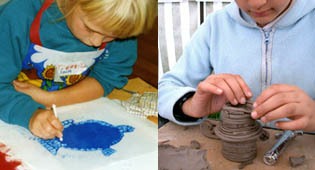











a historical perspective
Patterns and geometry
Before the advent of symbolic numbers, however, humans were using mathematical concepts in their craftwork -
How does the use of patterns, symmetry, shape and form develop without a concept of number? Mathematicians often talk of the beauty of natural forms, such as the regular division of petals, the beauty of seed heads, the designs on butterfly wings, which inspire their interest in mathematics. Which is very true, but they already have a concept and language of mathematics with which to look at these forms.
It seems unlikely that the development of patterns and symmetry are the result of abstract intellectual ideas on their own. We are so used to abstract symbols and abstract thinking we take this for granted -
'Making' technology
The craft of making useful things, however, could be the start of such ideas and concepts -
A lightweight basket requires the use of a minimum quantity of material to create a container of just the right three dimensional shape, and a multitude of grass stems have to be twisted and threaded together in exactly the right way to give maximum strength and flexibility in rope-
We know people were making such structures more than 10,000 years ago from the decorations found on pieces of ancient Neolithic pottery (the items themselves no longer exist as they are all biodegradable). Patterns of complex designs were taken from their woven and twisted baskets and reproduced onto clay pots, and patterns taken from fabrics can be seen adorning clay Neolithic icons and goddesses.
Neil MacGregor illustrates this beautifully in his book in the section on Jomon pots found in Japan from 10,000 years ago:
"This particular pot is initially quite dull to look at. It is a simple round pot about the size and shape of a bucket that children might play with on a beach… When you look more closely you can see that it was built up out of coils of clay and then fibres were pressed into the outside so that when you hold it you feel as though you are actually holding a basket. This small Jomon pot looks and feels like a basket in clay."
He goes on:
"Putting your food in sturdy clay pots kept freshness in, and mice out. It was a great innovation. But the shape and texture of the new pots the Jomon did not innovate: they looked at what they already had -
The basic patterns were applied using twisted plant fibres and twisted cords, and there was an amazing variety in the ways you could twist your cords -
resource link > Niel MacGregor: History of the world in 100 objects
So the physical process of making things naturally gives rise to decorative pattern making and design -
Practical activities are good starting points for learning maths, and children should have every opportunity to experience these activities so that these concepts become familiar by usage. Which they do in the first years of school and pre-
They play with sand and water, using cups, bottles and other containers of different sizes to gain practical knowledge of size and volume; they play with clay and plasticine to gain practical knowledge of shape, form, malleability and solidity; they build structures with wooden and plastic bricks and construction kits to gain practical knowledge of stability, strength and gravity, they even make cakes or biscuits which provides experience of measurement, mixing and transformation of materials.
All of these activities involve using mathematical concepts -
All to soon, however, abstract mathematical education takes over and the unfortunate process of disconnecting maths with the real world begins, and at the same time the underlying mathematical value of ‘making activities’ is undermined.
what do we mean -
• there is special knowledge and understanding to be gained by making things
• childhood plays a vital part in this innovative process
a historical perspective
• observation, trial and error
• origins of maths
• patterns and geometry
facing the future
growing concerns
• Neil MacGregor
• Sherry Turkle
• Seymour Papert